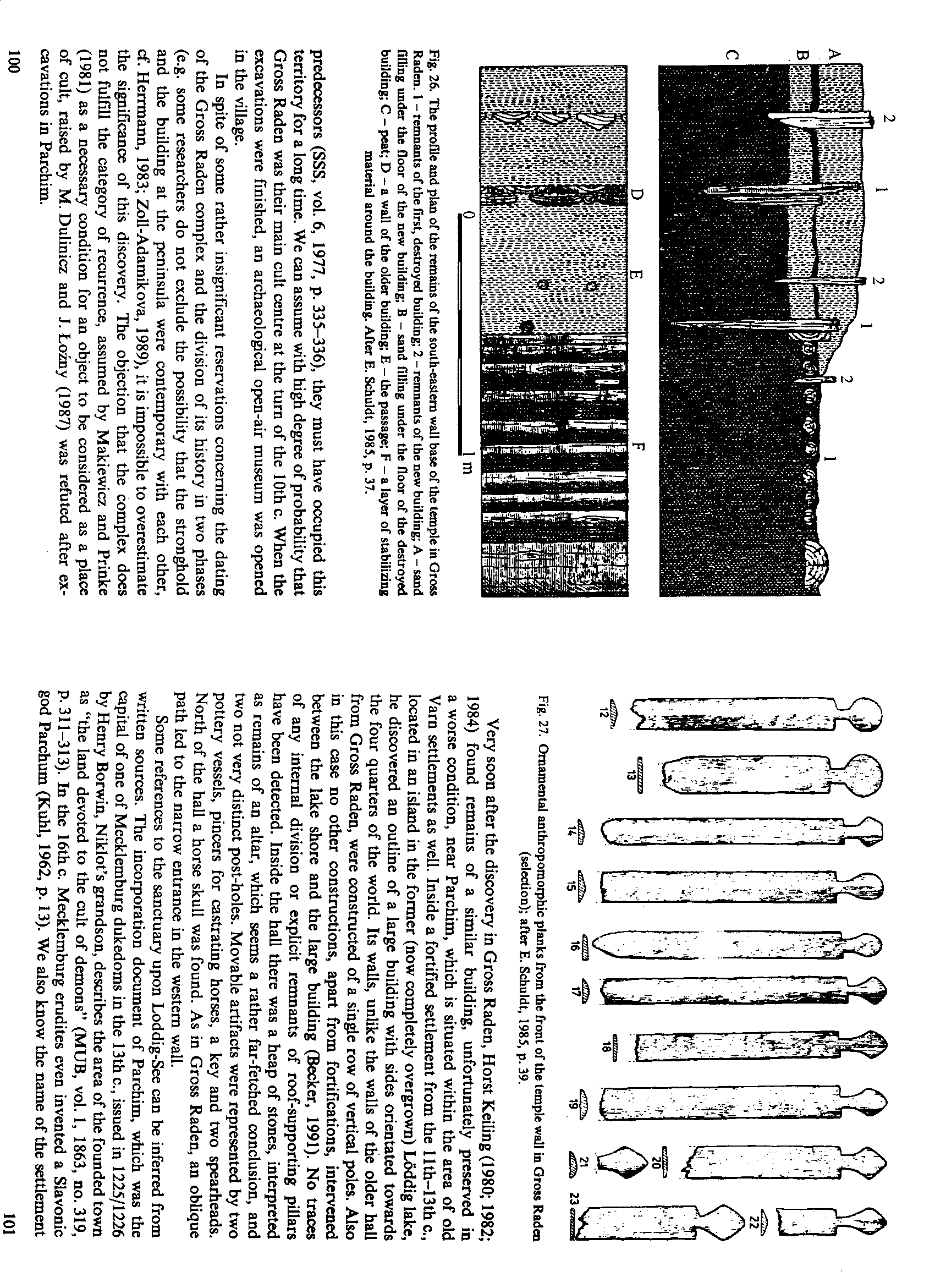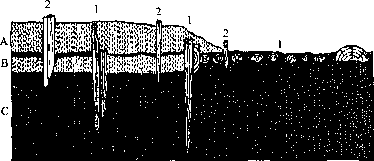image049



1 m
Fig. 26. The profile and plan of the remains of Ihe south-ea&tem wali base of the tempie in Gross Raden. 1 - remnants of the first, destroyed building; 2 - remnants of the new building; A - sand filling under the fioor of the new building; B - sand filling under the fioor of the destroyed building; C - peat; D - a wali of the older building; E - the passage; F - a layer of stabilizing materia] around the building. AfLer E. Schuldt, 1985, p. 37.
o
predecessors (SSS, vol. 6, 1977, p. 335-336), they must have occupied this territory for a long time. We can assume with high degree of probability that Gross Raden was their main cult centre at the turn of the lOth c. When the excavations were finished, an archaeological open-air museum was opened in the village.
In spite of sonie rather insignificant reservations concerning the dating of the Gross Raden complex and the division of its history in two phases (e.g. some researchers do not exclude the possibility that the stronghold and the building at the peninsula were contemporary with each other, cf. Herrmann, 1983; Zoll-Adamikova, 1989), it is impossible to overestimate the signiflcance of this discovery. The objection that the complex does not fulfill the category of recurrence, assumed by Makiewicz and Prinke (1981) as a necessary condition for an object to be considered as a place of cult, raised by M. DuLinicz and J. Łoźny (1987) was refuted after ex-cavations in Parchim.
fi
"! 'i'v
\J
19 23 C
Fig. 27. Omamental anthroporaorphic planks from the front of the tempie wali in Gross Raden (selection); after E. Schuldt, 1985, p. 39.
Very soon after the discovery in Gross Raden, Horst Keiling (1980; 1982; 1984) found remains of a similar building, unfortunately preserved in a worse condition, near Parchim, which is situated within the area of old Varn settlements as well. Inside a fortified settlement from the llth-13thc., located in an island in the former (now completely overgrown) Lóddig lakę, he discovered an outline of a large building with sides orientated towards the four ąuarters of the world. Its walls, unlike the walls of the older hall from Gross Raden, were constructed of a single row of vertical poles. Also in this case no other constructions, apart from fortifications, intervened between the lakę shore and the large building (Becker, 1991). No traces of any intemal division or explicit remnants of roof-supporting pillars have been detected. Inside the hall there was a heap of Stones, interpreted as remains of an altar, which seems a rather far-fetched conclusion, and two not very distinct post-holes. Movable artifacts were represented by two pottery yessels, pincers for castrating horses, a key and two spearheads. North of the hall a horse skuli was found. As in Gross Raden, an obliąue path led to the narrow entrance in the western wali.
Some references to the sanctuary upon Loddig-See can be inferred from written sources. The incorporation document of Parchim, which was the Capital of one of Mecklemburg dukedoms in the 13th c., issued in 1225/1226 by Henry Borwin, Niklofs grandson, describes the area of the founded town as “the land devoted to the cult of demons” (MUB, vol. 1, 1863, no. 319, p. 311-313). In the 16thc. Mecklemburg erudites even invented a Slavonic god Parchum (Kuhl, 1962, p. 13). We also know the name of the settlement
101
Wyszukiwarka
Podobne podstrony:
image078 Fig. 66. The sanctuary in Rzhavintse. Top: a plan of the stronghold with sounding excavatio
image047 Fig. 22. The location of the stronghold in Gross Raden. 1 - the stronghold in Gross Grónow;
image017 Fig. 10. The plan of the stronghold m Arcona reconstructed by H.Berlekamp and J.Herrmann. A
image008 Fig. 4. Possible reconstructions of the tempie in Old Uppsala, drawings based cm: A.-C. Sch
1.2. Goal and Plan of the Work 3 It is assumed that the goal of this work can be reached in the foll
image083 Fig. 67. The enthroning ceremony of a Carinthian prince on an engraving from Osłerreichisch
image089 Fig- 71. The stoi»e walls around the peak of Góra Dobrzeszowska. 1 - the internal wali; 2 -
image090 Fig. 73. The alleged sanctuary on Bogit mountain. The stronghold. The cult circle. The alle
image094 Fig. 75. The Krak Mound near Cracow. Photo L. Słupecki. is banished, and as the małe linę i
image018 Exterior septorum ordo Fig. 11. Niederle’s reconstruction of the tempie in Arcona based on
image042 Fig. 18. The topography of the early-raedjevaj Wolin. A - the presumed location of the temp
image064 Fig. 49. The alleged cult circle at Parsteiner lakę near Pehlitz. K - the drcle; R - ruins
image002 ORBIT 8 is the latest in this unique series of anthologies of the best new SF. Fourteen sto
IMGR33 (2) GILDING AND TECHNIQUES OF DECORATION sunulatcd in che woodcn moulds. When complctcd the w
image002 Figurę I: Distribution and spread of adansonii hybrid in South America. Adapted from Townse
image003 Figurę I: Distri bulion and sprcad of adansonii hybrid in South America. Adapted from Towns
87 (108) 168 The Viking Age in Denmark North Sea and thc Baltic, and also of craft activities. In th
więcej podobnych podstron